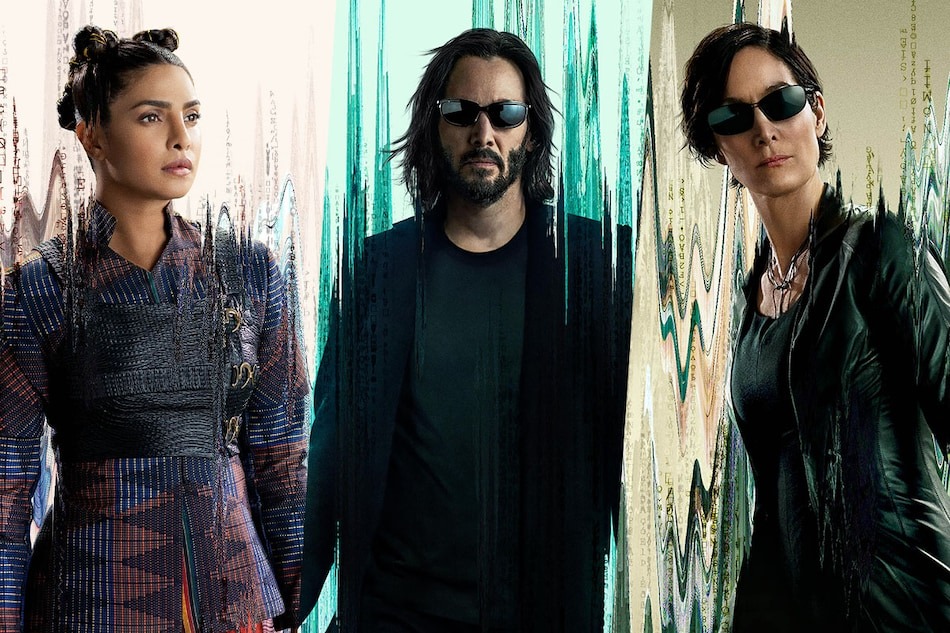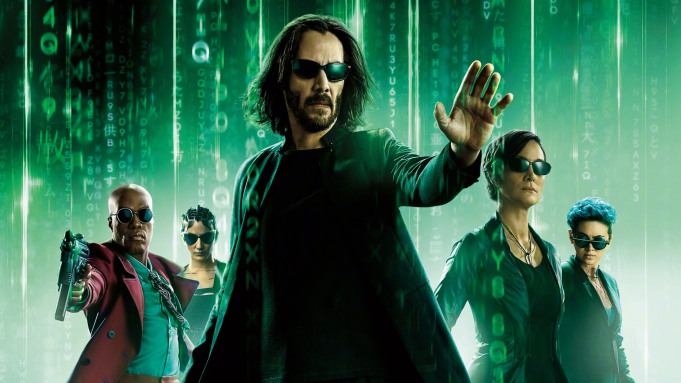
The Matrix Resurrections is the long awaited sequel to the Wachowski’s groundbreaking and divisive Matrix trilogy. Originally helmed by both Lana and Lilly Wachowski, the first Matrix, released in 1999, revolutionised both modern action and science fiction.
Not only were audiences subjected to never before seen special effects and immaculate choreography, it also understood what true science fiction is about. What does it mean to be human? What is the difference between reality and an illusion? What is our purpose? These themes are addressed once again in The Matrix Resurrections.
With the return of Lana Wachowski as director, featuring a screenplay by David Mitchell and Aleksander Hemon, The Matrix Resurrections picks up the story several years after the original trilogy concluded. Keanu Reeves reprises his role as the mysterious yet troubled Thomas Anderson, otherwise known as Neo, as he begins to question and doubt his own reality.
Considering the original trilogy’s finale, questions arose regarding how this new film would tackle the narrative. Despite everyone’s opinion on the last film, The Matrix Revolutions, it at least came to full conclusion.
A new direction
The Matrix Resurrections takes a very interesting approach. It at first appears to be retreading old territory, but it does so with an entirely new angle. Much like the first film, Neo struggles to find comfort in his own existence and battles with his own subconscious, unable to differentiate between reality and fiction. But where the first film thrives on seeking the truth, Resurrections travels down a more meta and critical path.
Almost the entire first half is dedicated to acknowledging its own existence. Wachowski, Mitchell and Hemon cleverly address the previous films in a similar vein as Wes Craven’s New Nightmare, making the audience question: do the previous films even exist in this incarnation of The Matrix?
This first half brilliantly entices the audience. It blurs the lines between reality and fiction in ways the previous films hadn’t even considered. Lana Wachowski uses the film to criticise its very existence, practically breaking the fourth wall to discuss whether or not a fourth Matrix film is necessary. Where this could come across as mean-spirited and spiteful, it instead uses these critiques to expand the story into a unique and fascinating direction.
Neo virtually represents Lana Wachowski herself, wanting to move on with his life and leave The Matrix behind. While his CEO, played by Jonathan Gross, represents Warner Bros. and their demands for a sequel. The character Bugs (Jessica Henwick) also feels like a representation of the audience’s fandom and their thirst for more.
These elements elevate the first half sublimely, but Wachoski still finds a way to give the characters space to breathe. Surprisingly, one of the film’s greatest strengths are the performances of Reeves and Carrie-Ann Moss (reprising her role as Trinity). Where their chemistry in previous films has been subject to criticism, here they feel far more natural, relatable and most importantly, human. They are given time to express their feelings, desires and worries. Unlike the previous films, they feel like genuine people.
Another shining addition is Henwick’s Bugs. Henwick brings tremendous energy and charisma to the film, while her chemistry with Reeves and Yahya Abdul-Mateen II (Morpheus) feels incredibly organic.
Abdul-Mateen II also provides us with an interesting performance. He finds a good balance between paying homage to Laurence Fishburne’s Morpheus while still managing to bring his own personality to the character. Though he may not carry the same weight or significance as Fishburne, he does succeed in creating an intriguing new look at the beloved character.
The first hour of Resurrections asks a lot of complex and interesting questions and creates a world that is both familiar and unique. One of the most notable elements is the visuals. Wachoski brings a new look to the franchise. Where the previous films were darker and more oppressive, here the visuals are uplifting and colourful, highlighting that this is not the Matrix we have seen before. This is aided greatly by some superb editing.
Wachoski brilliantly manages to weave in visual call backs to the previous films, seamlessly blending the old with the new. This works well enough in early action scenes, but it is used more effectively in the film’s quieter moments. Moments where Neo’s fears and anxiety begin to battle with his own sanity.

Major issues
Unfortunately, despite a well crafted and intelligent set up, the film begins to fall apart in the second half. While the film doesn’t exactly fall flat, it does slowly deteriorate as it struggles to find a direction to take the narrative. It is here where the writing, directing and even the acting begins its decline.
One of the film’s biggest issues is its antagonists. Not only does the film struggle to focus on a single primary antagonist, but their motivations are not particularly well realised. Some are set up in the first act while others are revealed towards the third. Some actors reprise their roles from previous films, others are recast altogether. However, despite reprising a role or being recast, each antagonist struggles to carry any weight or presence to their character. Sadly, the villains appear forced, un-threatening and, at times, just silly.
Much like the writing, the editing also begins to suffer. Where visual callbacks to previous films were used smoothly and effectively in the first half, they quickly become distracting and unnecessary in the second. They are no longer used to conflict with Neo’s subconscious, nor are they elegantly weaved between new footage. Instead it begins to feel unnatural and even lazy. This leads into one of the most disappointing elements, especially for a Matrix film; the action.
The original Matrix trilogy completely reinvented modern action, from mesmerising special effects to genuinely breathtaking choreography. Bullet time, martial arts, gun-play, the original films revolutionised them all. Hence it is incredibly disheartening to see Resurrections take such a mediocre approach.
The action is by no means terrible. There are some interesting shots and reasonably entertaining fight scenes. Unfortunately the action itself is painfully generic. When you think of martial arts in film your mind travels straight to the brutal subway fight from the first Matrix. When you think of famous car chases, you think of the intense and lengthy highway scene in The Matrix Reloaded, taking every advantage from its setting as it can.
Resurrections however, delivers some choppy fight scenes and some depressingly bland car chases. Where the previous films allowed for long, uncut shots featuring jaw dropping choreography, Resurrections is filled with fast editing and shaky cameras, which at times make it difficult to see what’s happening.
Other times the action is used to create a sense of dread and terror, only to then turn fall into a more ridiculous and comical territory. Not to mention the very strong use of plot armour that make the characters’ struggles feel less significant. The action as a whole is fine, but for a franchise like The Matrix, it is very underwhelming.
Finally, despite Bugs and Morpheus, the majority of new characters introduced are fairly generic and rather forgettable. The supporting cast serve their characters well enough and do the best they can with the material they are given, they just aren’t particularly interesting. You never feel invested in their survival as it is hard to relate or even remember them. This, alongside the choppy action, make it difficult to get invested in their journey.
The positives
Although there are plenty of flaws to dissect, there are elements of the second half that work well. Many of the ideas and themes explored do provide some interesting and thought provoking questions. Some of the answers also create intriguing views and opinions.
One scene in particular, towards the end of the second act, attempts to discuss the purpose behind this new version of the Matrix. Although it can come across as an unnatural and forced exposition dump, it does present an interesting idea that has not been explored in the previous films. It was just delivered in a hand-fisted manner.
Resurrections also addresses issues audiences have had with the original films, most notably the morality of extracting people from the Matrix. Where this was touched upon in the first film, Resurrections takes its time to discuss whether or not it is morally acceptable to remove someone from the Matrix without their consent. Is it wrong to subject someone to the harsh environment of the real world? Should they be freed from the illusion or left in ignorance? It is a welcome discussion that the previous films should have explored further.
Final thoughts
Despite many of its issues The Matrix Resurrections does at least carry many of the same themes and beliefs of its predecessors, while also managing to take them into a new direction. While it does at times struggle to answer these questions naturally, the answers themselves are fairly thought provoking and intelligent.
Although it can’t quite find a clear path through its narrative, and the structure can feel choppy at best, it does present some clever concepts and shows us some fascinating visuals. Alongside the performances by Reeves, Moss and Henwick, Resurrections is an entertaining experience that at the very least creates an engaging scenario that leaves the audience with enough to analyse and discuss. It is not a perfect film and it has its issues, but it is worth viewing on the big screen. It certainly isn’t the best Matrix film, but it is far from the worst.
The Matrix Resurrections is currently playing at Kingston Odeon.





